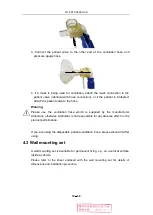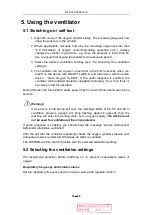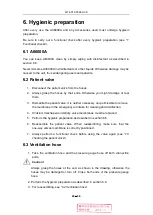
H-1.601.00024-A3.0
10
–
46
4. Installation
A permanent mounting is usually necessary only when AII6000A is installed as a
fixture in rescue vehicles, helicopters or aircraft .If AII6000A is supplied complete on a
carrying platform or in an emergency rucksack, it is ready for use and requires no
further installation. Separate directions for use are supplied for carrying platforms and
emergency rucksacks.
Caution:
In order to ensure safe and reliable operation, functional tests must be carried
out aft
er installation (see “7. Functional checks”).
4.1 Connecting the oxygen cylinder
Caution:
Always wash your hands thoroughly before starting any work on the oxygen
supply. Products containing hydrocarbons (e.g. oils, greases, alcohols, hand
creams, sticking plasters) may cause explosive reactions if they come into
contact with high-pressure oxygen.
Never use wrenches or similar tools to tighten or loosen the screw
connections.
Removing the empty cylinder
Close the valve of the oxygen cylinder. Switch on AII6000A with ON/OFF
switch 9. This exhausts any residual oxygen and depressurizes the
ventilator. Wait until the pressure gauge on the pressure reducer shows an
oxygen content of zero before undoing the screw connection by hand.
Switch off AII6000A with ON/OFF switch 9.
Then loosen the screw of reducing valve connected to the cylinder.
Connecting the new cylinder
1. First briefly open and close the valve of the new oxygen cylinder. This
should blow out any particulate matter.
Caution:
Keep the valve opening away from the body, making sure that neither
yourself nor other persons can be injured by escaping particles.
2. Next use the fluted connecting nut to couple the pressure reducer to the
valve on the oxygen cylinder. Tighten the connecting nut by hand.
















































